ALLIGATOR
BEHAVIOR page 2j: SOCIAL SIGNALS AND BELLOWING 10 1 2 3 4 5 6 7 8 9
This page was born 08/24/2023. Rickubis designed
it. (such as it is.) Last update: 11/11/2024
Images and contents on this
page copyright © 2001 - 2024 Richard M. Dashnau
Alligators, although they are ectothermic and also
equipped with a small brain, exhibit a surprising diversity in
their responses to their environment and to each other. They
are for more complex than mere animated logs or 12-foot-long
eating machines. This group of pages show some of what I've been
able to see in the years I've been
volunteering (September of 2001 thru August of 2023) at Brazos
Bend State Park.
More
from 10/13/2024
At
BBSP -a few
hours after
the bellowing
bout I
described
below-there
was a large
alligator
basking on the
Spillway near
the center of
the
Spillway
Trail. I
watched it
from the
bridge, and
had time to
inspect it
(with
binoculars and
camera) for
any scars and
leeches. It
was also a
place to talk
to park
visitors about
alligator
anatomy and
behavior. The
alligator
began to
"thermal
gape", and I
expected it to
enter the
water soon. A
"thermal gape"
is when the
alligator
opens its
mouth so that
the jaws make
about an
30-degree
angle. This
exposes the
moist tissues
inside to
allow them to
cool by
evaporation.
While this
probably won't
work to cool
the entire
alligator, it
can
cool the blood
in the head.
In my
experience, it
usually means
the alligator
is overheated
(or at least
its head is)
and will be
going back
into the water
to cool.




And
that's what
this alligator
did.
Unfortunately,
another
alligator was
in the water
nearby, and
that alligator
wasn't
comfortable
with that. So
it did an
warning lunge.
But that's
all. There
was no further
aggression.
When I
examined the
lunging
alligator
closely
(through
binoculars) it
seemed to have
damage in both
eyes. I
believe that
alligator is
the same
female that
had been with
a pod of
babies over
the last year
or two.
Some of the
story of that
female and her
pod can be
seen on my
web page here.



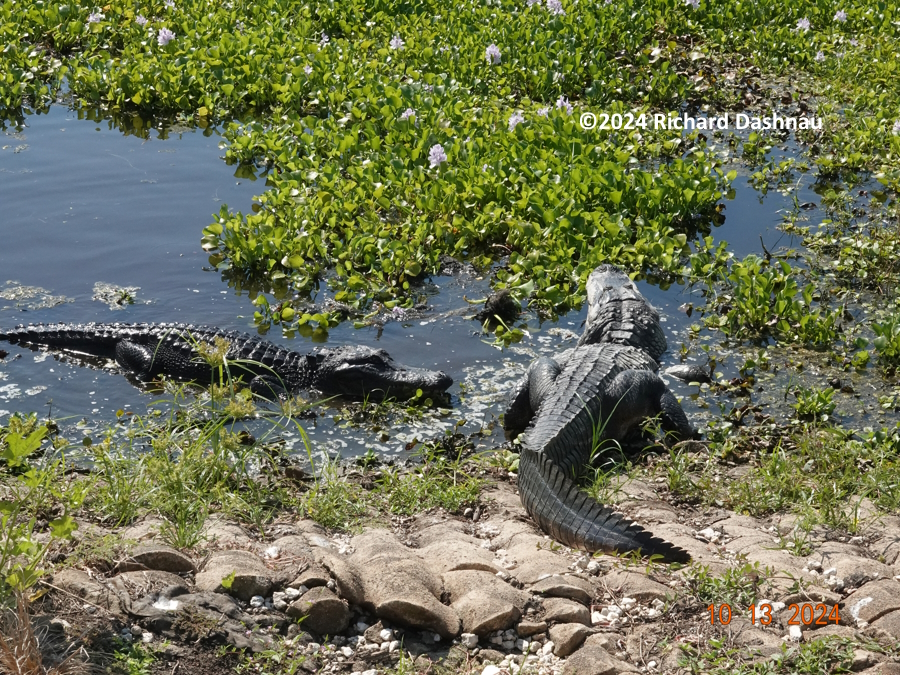
That
female had
been about 30
yards further
East, and on
both sides of
the Spillway
trail at
various times.
I didn't try
to take close
pictures of
her eyes to
record this
identification
because the
lighting was
not favorable
for it.
I regret that
now.


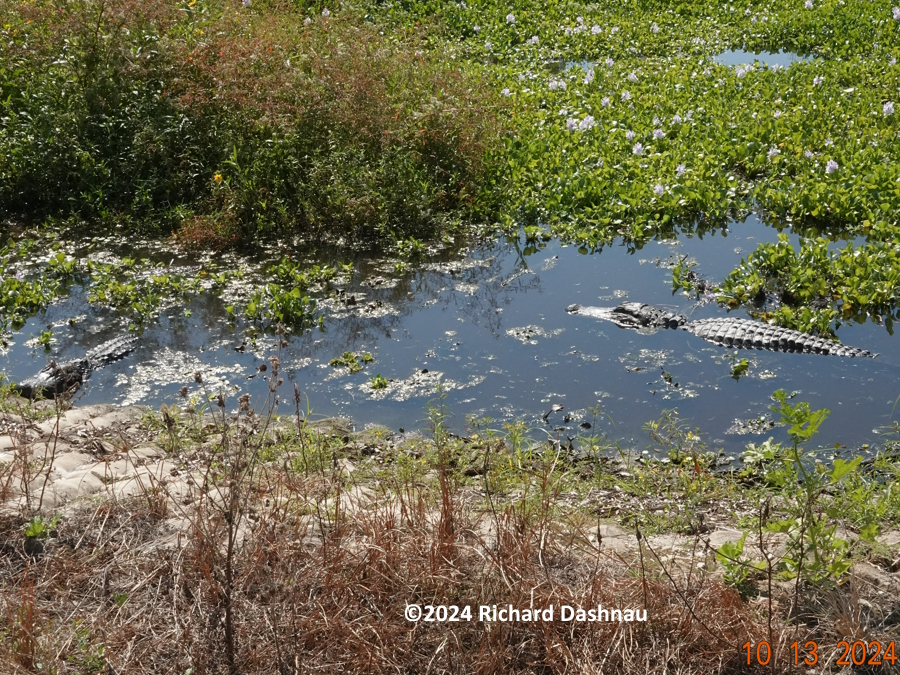
10/13/2024
At
BBSP, about
9:30am, I was
at the East
end of the
Spillway
Trail, where
it meets the
Elm Lake
trail. There
was an
alligator up
near the
trail,
some distance
from the
water. I
could see that
it had a hole
in its gular
pouch, and a
lump of flesh
showed under
its jaw. I've
seen other
alligators
with similar
gular wounds
over the
years, and
they hadn't
seemed
distressed by
them. This one
seemed to be
acting normal,
also.
The alligator
was still wet,
and I started
looking for
another
alligator
in the water.
I did this
because this
is not a
common basking
spot, and I
figured that
this alligator
might have
been avoiding
another
alligator. The
wound in its
gular pouch
was not fresh,
so was not
from this day.
There was
another
alligator in
the water, and
I watched both
gators for any
sign of
awareness
between them.




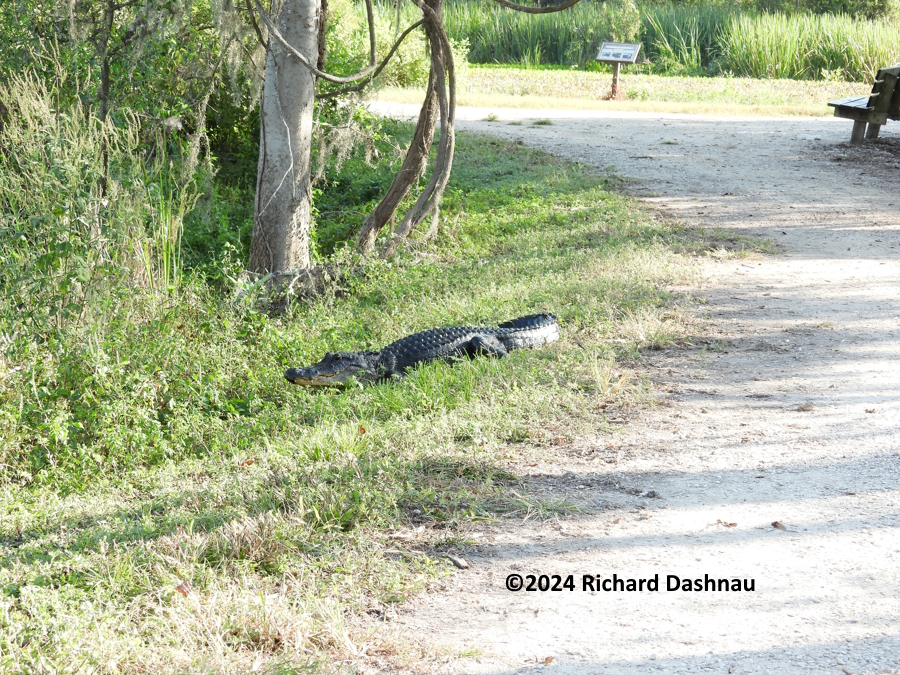
Both
alligators
moved around
in their
respective
areas. The one
on the grass
shifted
positions a
bit, and
ignored
various
visitors that
passed by.
About 9:50,
the alligator
moved off the
grass and into
the
water.
Even then,
both
alligators
ignored each
other for a
while--until
the wounded
gator moved
towards the
other
alligator.
Even though
the other
alligator was
much larger,
the smaller
one moved up
and
"intercepted"
it, about
10:10.
The smaller
gator moved
slowly until
it gently
bumped its
snout against
the
other
alligator's
snout. Then,
it gently
pushed the
larger
alligator
(which was
floating
freely) and turned
it around.




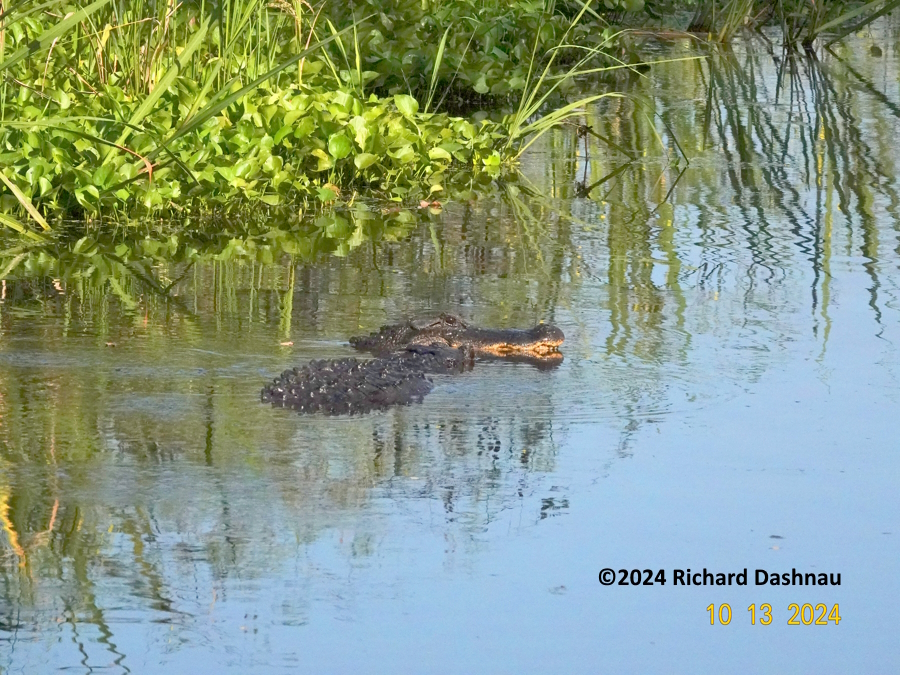
The
smaller gator
continued
pushing,
resting its
lower jaw on
the snout of
the larger
gator. It
moved off the
gator, swam
around it, and
towards the
gator's
tail.
The bigger
gator started
to bellow
repeatedly (a
"bout" of
bellowing). I
was narrating
events for a
group of
visitors, so
did not count
the number of
bellows in
each bout.




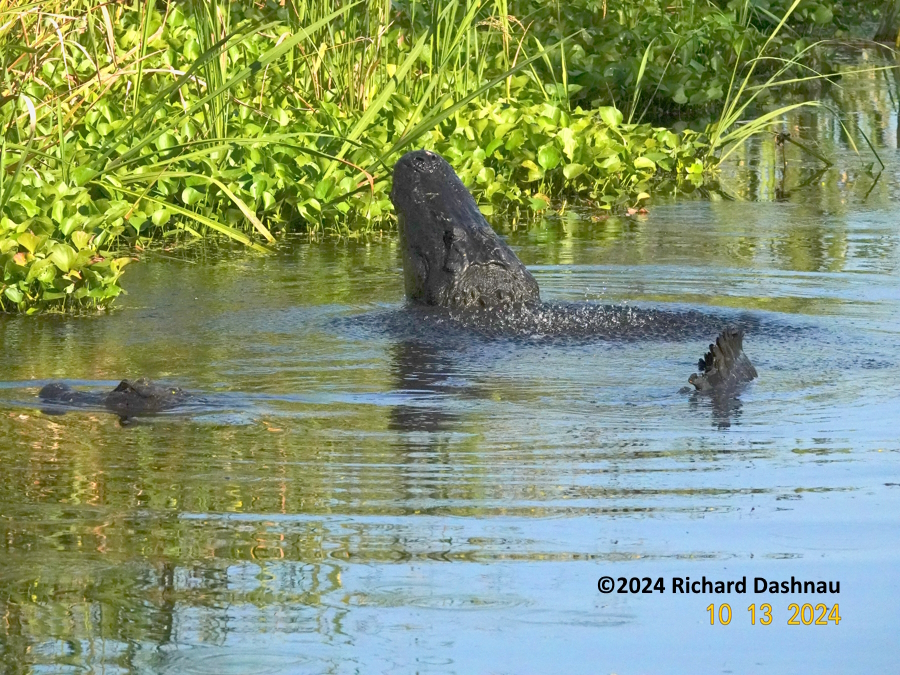
The
water above
the larger
gator danced
from standing
Faraday waves.
That, and the
deep "choppy"
sound
indicated it
was a male. It
moved into
shallower
water and kept
bellowing.
Bellowing
gators often
move to
shallower
water so they
can do the
"pushup"
behavior with
their front
legs. The
images below
show the "head
oblique,
tail arched"
(HOTA)
described in
"the
literature".




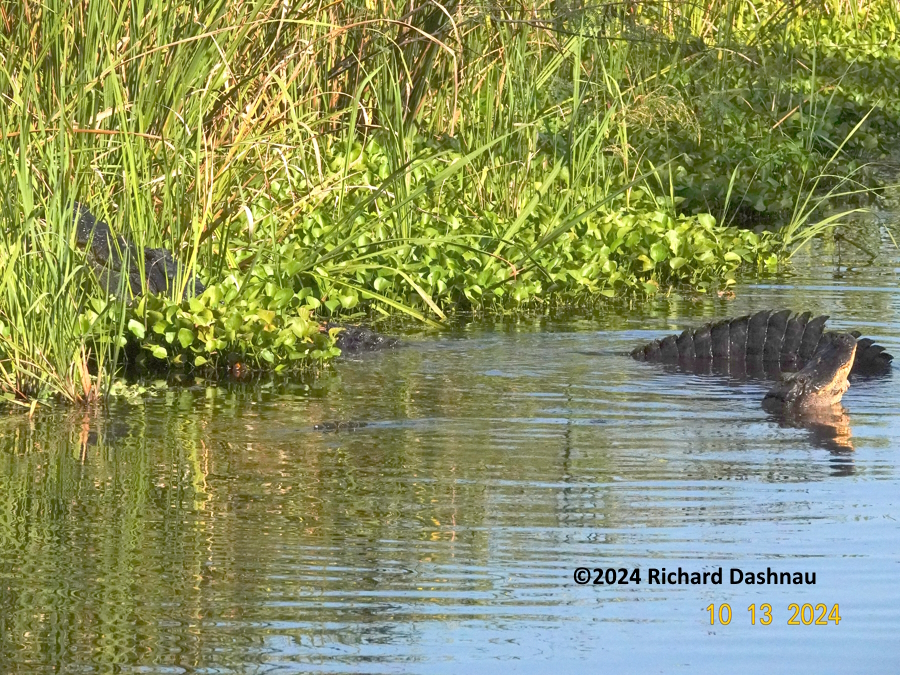
The
damaged
alligator also
bellowed. It
remained in
deeper water,
showing only
its head and
tail. Lack of
the Faraday
waves from
Sub-audible
Vibrations
(SAV) and the
smoother sound
showed it was
most likely a
female.
Some of the
difference
could have
been from lack
of acoustic
resonance
because of the
hole in its
jaw, but
that's just a
guess. I've
put together this
edited video
from some of
these images
and some very
short video
clips (one or
two bellows).



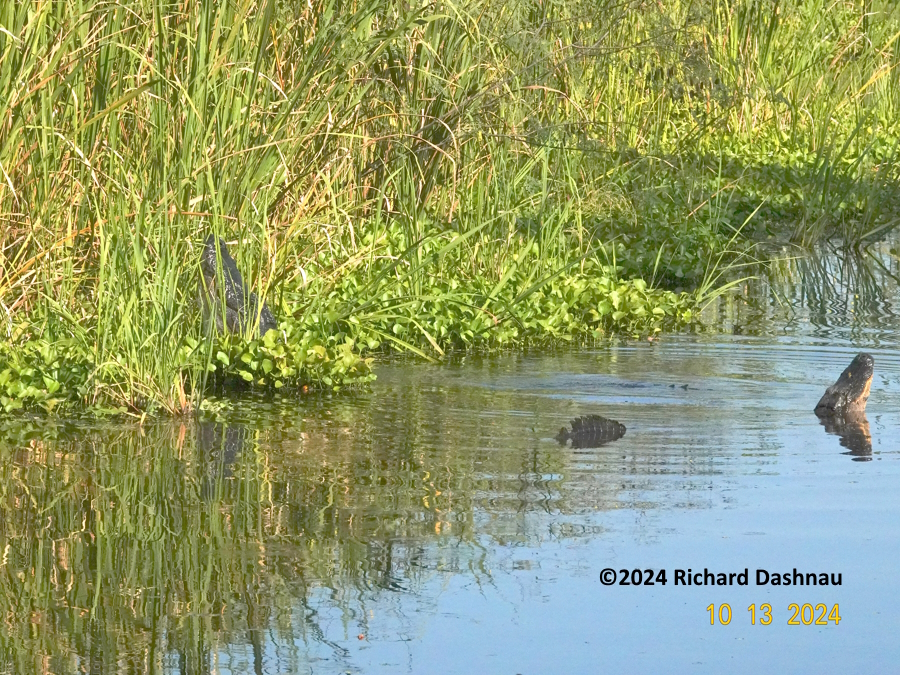
So,
what's going
on here?
Alligator
courtship/mating
season is
March - May,
and they lay
eggs in June.
This is
October! Well,
the gators
don't ever
tell me.
Over the
20+ years I've
been
volunteering
at BBSP, I've
read a lot of
"the
literature",
and personally
observed (and
recorded) all
kinds of
alligator
behavior.
Sometimes,
it's good
to go back an
review a few
things, so I
did that
again.
Sometime in
2002, I found
a copy of
"SOCIAL
SIGNALS OF
ADULT AMERICAN
ALLIGATORS by
Leslie D.
Garrick,
Jeffrey W.
Lang, Harold
A. Herzog, JR.
(1978)
It is a key
source for a
listing and
identification
of these
signals.
Reports
written in
later
years cite
this one, and
have added
further
observations
and
interpretations
of the
behaviors
described.
This one is
still very
good. Here are
some comments
from
that source
[italics are
mine]: "Each
vocalization
is termed a
'bellow'; the
events from
bellow to
bellow are a
'bellowing
cycle', a
series of
bellows by one
animal is
a
'bout', a
group of
animals
bellowing is a
'chorus', and
the duration
of the chorus
or groups of
choruses is a
'session'."
p.164
"A more
standardized
value of
broadcast
range can be
approximated
by measuring
the loudness
of the
vocalization.
Herzog
measured the
loudness (the
sound
pressure or
SPL) of
bellows during
the morning
chorus at RARI
on three days
and found that
at distances
from 3-6 m.
when animals
faced toward
the observer,
maximum SPL
ranged from 84
to 92 db.,
and when
facing away
from the
meter, maximum
SPL ranged
from 70 to
76 db. For
comparison, a
SPL of 100
db. is the
noise made by
a small
propeller
aircraft at a
distance of 5
m."
p.167
"In Louisiana,
bellowing,
which
definitely was
associated
with
courtship,
peaked in May
and frequently
was observed
from mid to
late April
through early
June.
Fogarty
(1974) noted a
May peak for
bellowing in
the Everglades
(Florida)."
p.168
"Thus our
observations
are
corroborated
by the above
reports and it
can be
concluded that
bellowing is
seasonal,
coinciding
with the
warmth of
spring and
onset
of
breeding
activity; that
bellowing
occurs
simultaneously
with courtship
activity; that
bellowing
continues
after the eggs
are laid; and
that some
bellowing can
be
heard in
late
summer and in
early fall,
but rarely
during the
winter."
p.168
"Bellowing was
clearly an
early morning
activity.
During the 63
days of spring
observation
(March 24 to
June 14)
bellowing was
observed
within 129
hours out of
a possible
1512 hrs. (24
by 63). During
these 129
hrs., 72
percent of
bellowing
bouts occurred
between 0600
and 1000. The
median hour
when most
bellowing
occurred was
between 0800
and 0900."
p.168
In
2001, I had to
order my copy
and have it
mailed to me
(I still have
it.). Now, it
is available
online, for
free, at
this link,
from the
American
Museum of
Natural
History.
And, this is
from a more
recent source,
the book
American
Alligators:
Habitats,
Behaviors, and
Threats
Edited By
Scott E. Henke
and Cord B.
Eversole
(2018)
From
page 98 (in
Chapter 5;
Alligator
Reproduction:
Courting,
Breeding, and
Nesting
Behavior, by
Ted Joanen and
Mark Merchant
P. 97 - P.
122)[italics
are mine]
"Although
bellowing
occasionally
occurs during
warm late
winter and
summer
days, it
occurs with
more
regularity in
early April.
The frequency
of bellowing
depends
on prevailing
climate and
occurs in
higher
frequencies on
mild spring
mornings with
no wind.
Bellowing by
both sexes
increases
sharply in May
and occurs
daily
through the
first week in
June. Vocal
displays can
be heard quite
often at
night, but not
with the
regularity and
definitive
timing as in
the early
morning.
After
this peak,
sporadic
bellowing
occurs
throughout the
remainder of
the
year.
Generally,
bellowing is
induced by
changes in
climate for
periods other
than the
spring, e.g.,
after heavy
thunderstorms
in the summer
or after
early cold
fronts in the
fall.
Although both
sexes bellow,
the
vocalization
produced by
males is lower
in
frequency and
louder than
that produced
by females,
which tend to
be much higher
pitched and
less
percussive.
The bellowing
posture is
similar for
both sexes.
The head and
tail are
lifted up out
of the water
with the chin
tilted up, and
the dorsal
scutes are
just below to
slightly above
the surface of
the water.
Garrick et al.
(1978) studied
the vocal
displays in a
captive group
of alligators
in south
Florida and
reported six
distinct vocal
signals:
bellow, bellow
growl,
deep
grunt,
low growl,
cough,
and hiss. All
of these
vocalizations
can be heard
during the
courtship
period."
(page 98)
Note that
"Garrick et.
al. (1978)" is
the same study
I linked to
above.
One thing
about many of
these studies
is that
although
behaviors are
described as
communication
or
signaling--what
they actually
mean
is not
described.
6/02/2024
(about 30 minutes before I saw the alligators fighting shown on another
page.) An alligator swimming fast enough to produce a wake usually has its
attention on something--in
front of it or...behind it. The one in front slowed and
turned sideways with a slight tail arch to signal to the one following.
That allowed the follower to come up. The situation did not
escalate, and the follower moved past and continued. I'm not sure why
either alligator chose to swim East along the North side of the Spillway
Trail that morning. All of the events I
describe here are also shown in this edited video.





The
larger alligator started following the one that had been behind it.
Sometimes I can recognize an alligator because of unusual scars or other
marks. This one has some osteoderms
that seem odd on this side, low center. When following an alligator
swimming parallel to me, I try to get in front of it so it passes
by. I also try to get past trees and plants that block the view.





The
larger alligator caught up to the smaller one, which moved off to the edge
of one of the island mounds. It was all relaxed, quiet interaction.





When I
passed some plants, I saw something swimming in the water. I was ahead of
the alligator, and was watching for it. I expected it to swim past this
small disturbance; but it didn't.
Even though the item was small, the alligator still chewed on it for a bit
before swallowing it. Then the alligator moved on, with cicadas and
bullfrogs, and LOTS of birds calling in the
background.





I
followed the alligator a little past the Gator Nesting plaque, then
lost it when I stopped to talk to some visitors. Gators nearby started
bellowing few minutes later, but I didn't get them on
video (but I followed the sound to the events on top of the page).



07/30/2023
Brazos Bend State Park is still recovering from the drought of last year.
Pilant Lake looks better than it did last July. The lake also looks
quite different than it did over
the past few years, since different plants appeared during the dry
spell last summer.

A
large alligator had been following a slightly smaller one. The small one
moved around some plants and avoided the large one. When both gators
stopped moving, I walked away.
I hurried back when I heard the gators bellowing. Although
most bellowing happens during mating season, alligators may bellow at
other times. Mating season ends before June.
I can only guess why the first alligator bellowed (and which one it was).
But one bellow can start a chorus of answering calls.
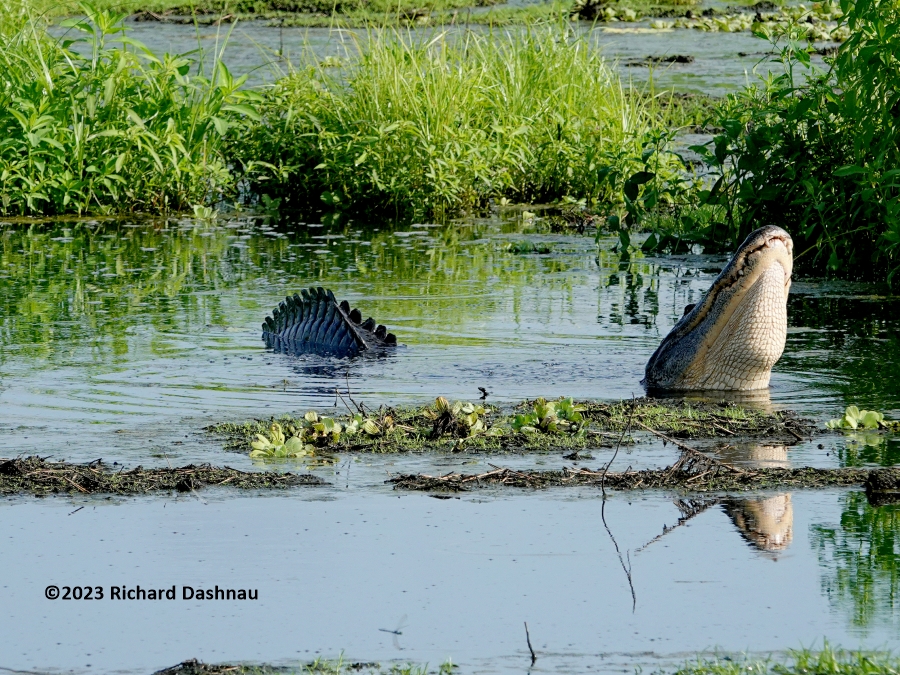
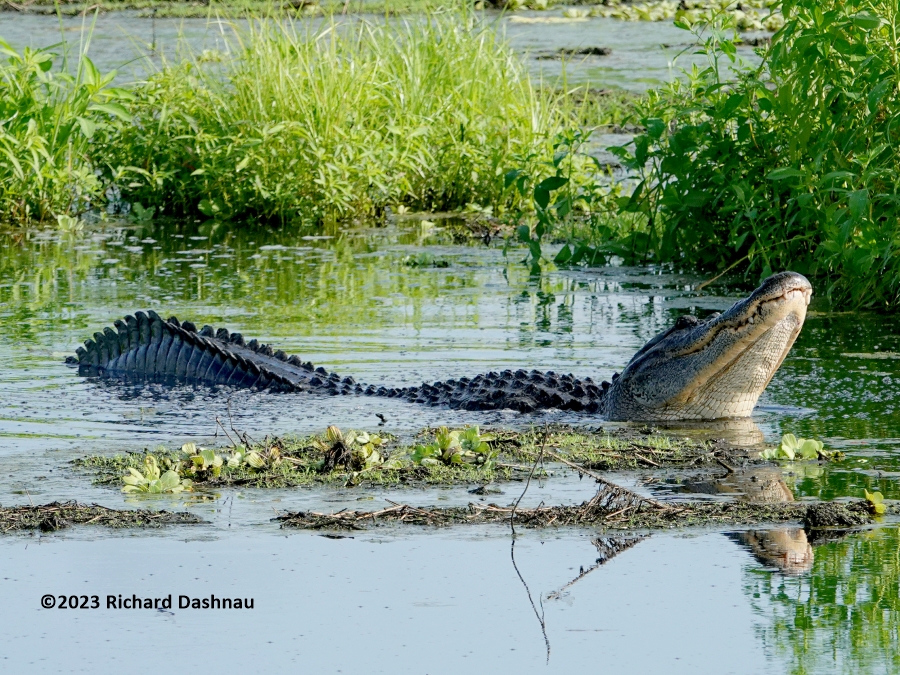
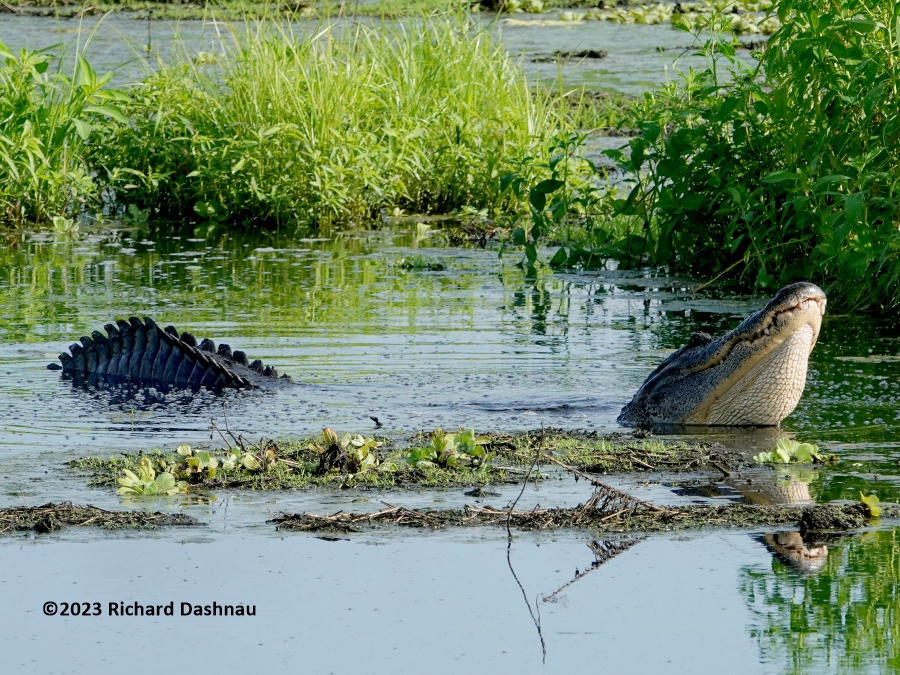
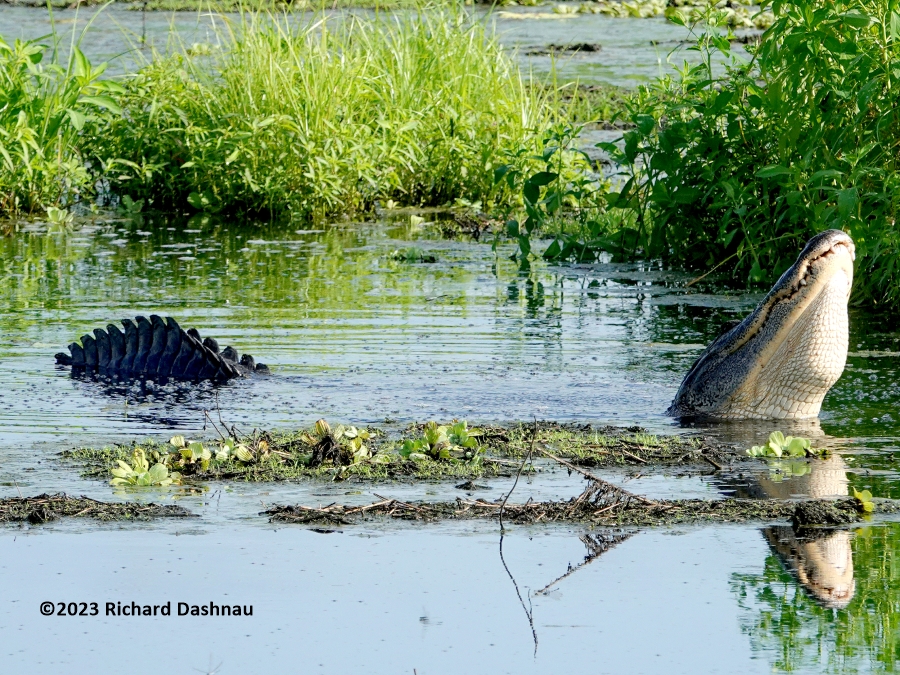
An
hour later, the large gator was still feisty. It was in "head oblique,
tail arched (HOTA)" position, so I prepared for the alligator to say
something else. The gator did a head-slap!
The two Green Herons that were hunting nearby were not happy about it;
especially the one on the branch, which seemed to scold the gator. With
the head-slap slowed 3 times, we
can see that the gator transmitted a SAV (subaudible vibration) by
fluttering its back during the headslap. Both of these signals can
be heard and seen in this short edited video.
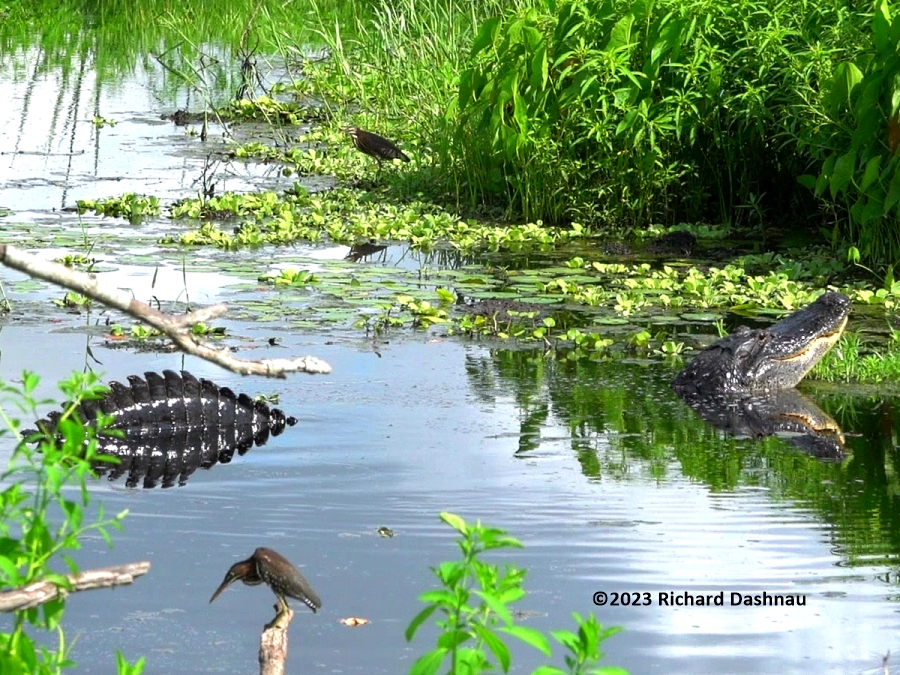
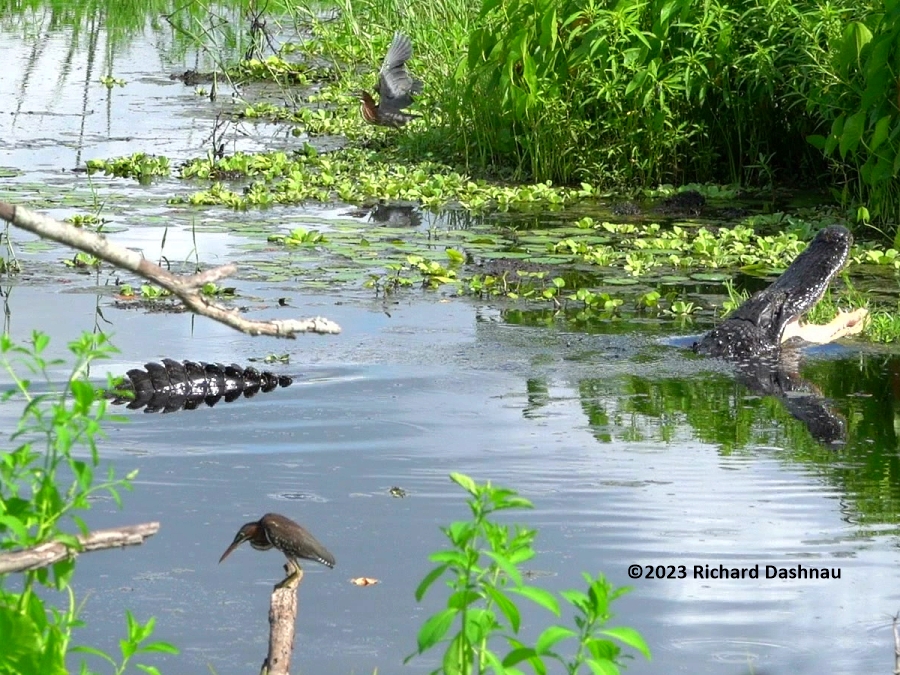
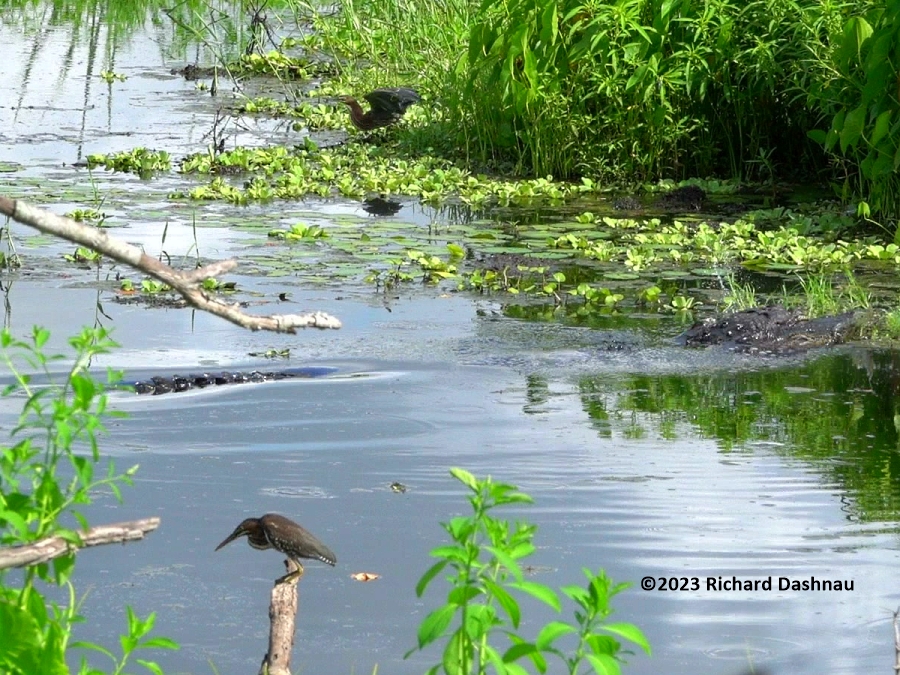
Alligators
can transmit a lot of information to other gators through various
vocalizations and movements. They can "filter" ambient sounds (such as
bullfrog calls) so they can ignore
them. One study suggests that an alligator can discern the size of a
calling alligator by sound of its bellow. It's hard to say why this
alligator was so demonstrative on this day. This
environment has all kinds of animals which fill the area with sounds
and movement. The signals of alligators are within that blend, and
only the alligators can decode them.
On 04/09/2023 It
was about 61° F at 8:40am on the 40 Acre Lake trail near Pilant Lake. I
could hear alligators bellowing from some distance somewhere in
the lake. I'd hoped to see
some of the bellowers, but thought I'd be disappointed when I
couldn't find them and the bellowing stopped. About 15 minutes
later, some alligators came into view, although they
were still at least 50 yards away. When the distant bellowing
started again the alligators began to move. I thought that they
might join the chorus, so they'd want to move to a shallow
spot--like that little island where the Great Blue Heron was
standing. Instead, luck was with me, as the alligators moved towards
me! And then they started to bellow.
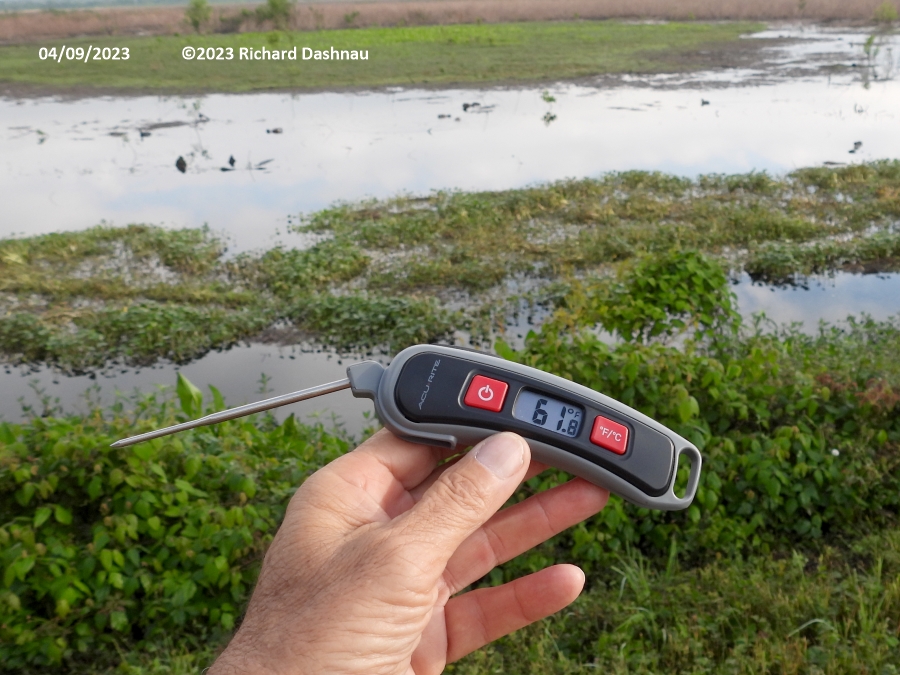
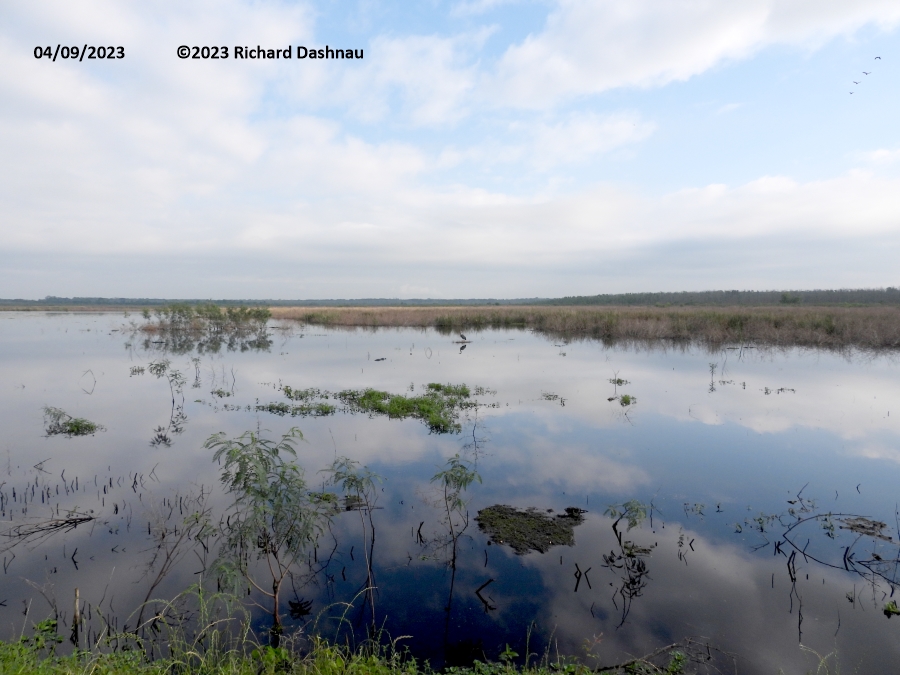
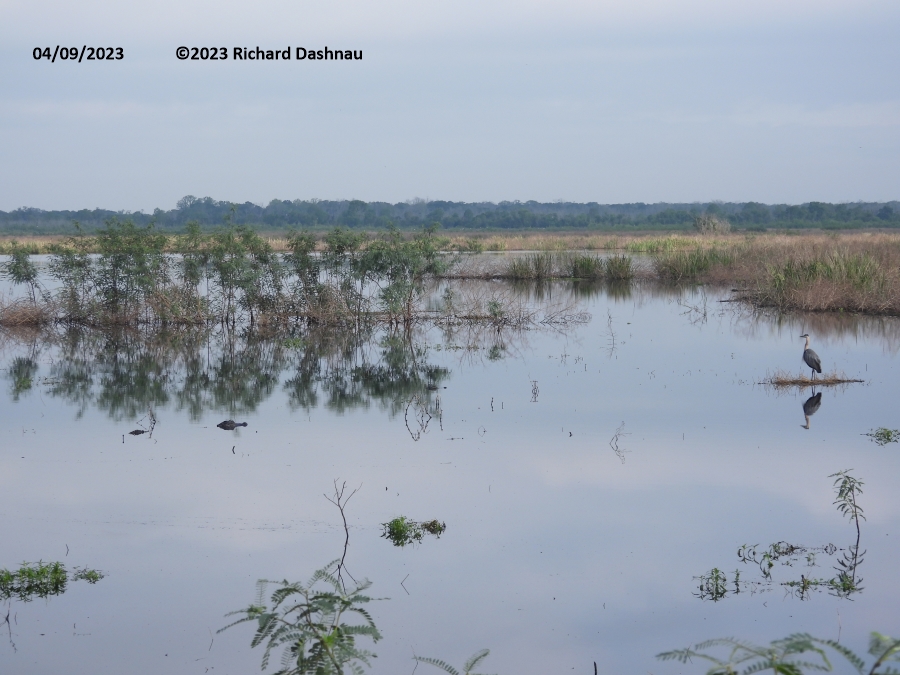
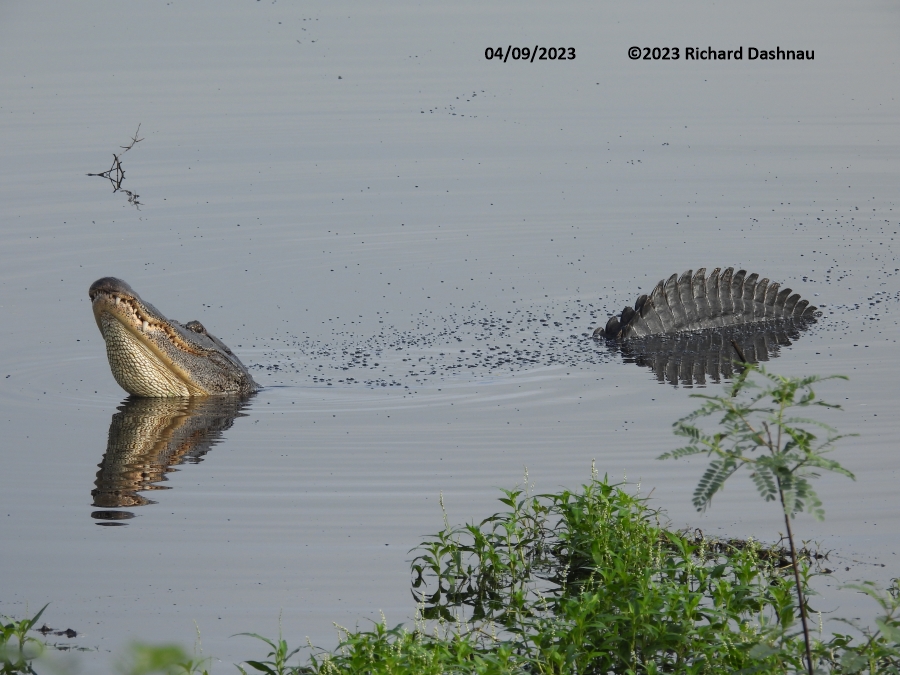
It
sounded like 2 males and at least 2 females. I could see them, but both
males were submerged deeper than usual, so there was limited
"water-dancing" over them. This made
visual identification difficult. Two of the females moved to the male that
had been bellowing in front of me.
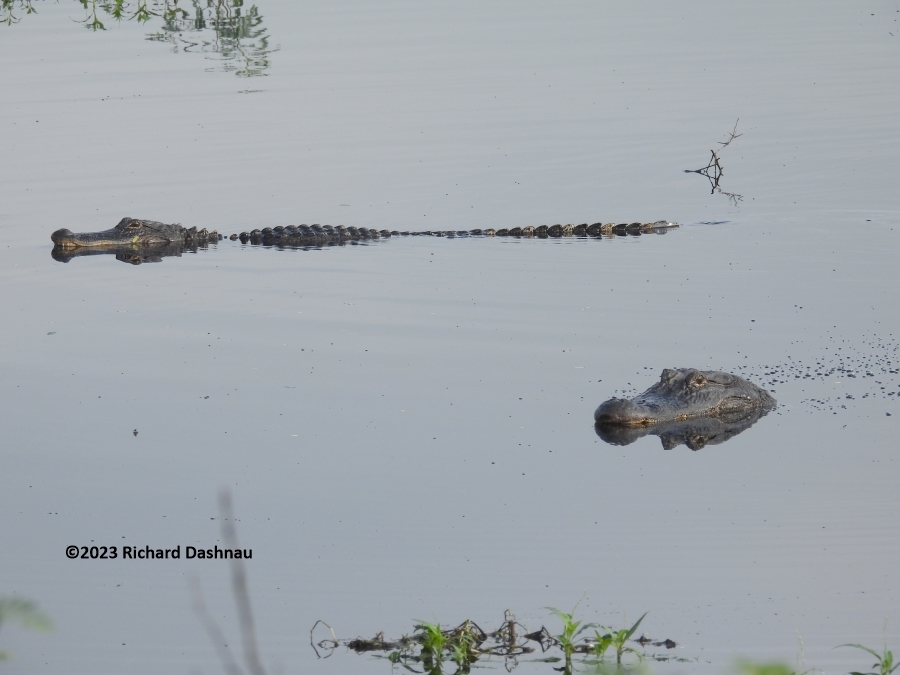
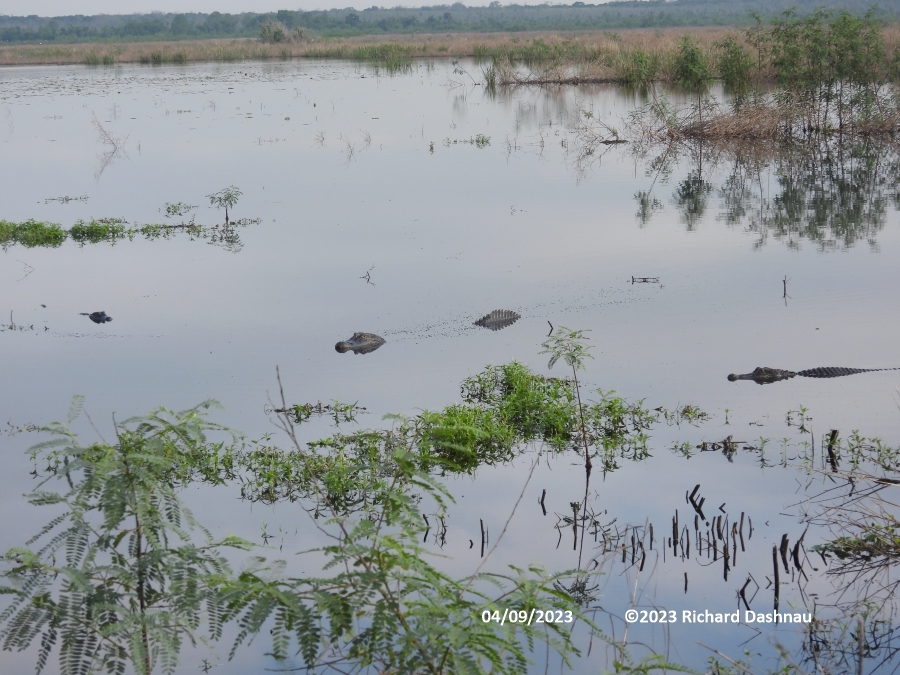
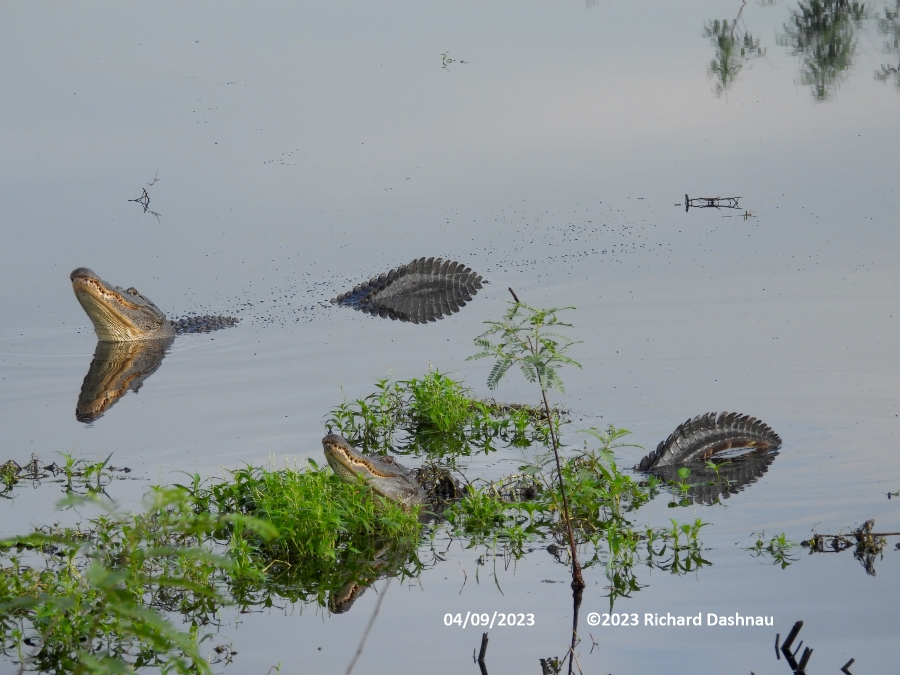
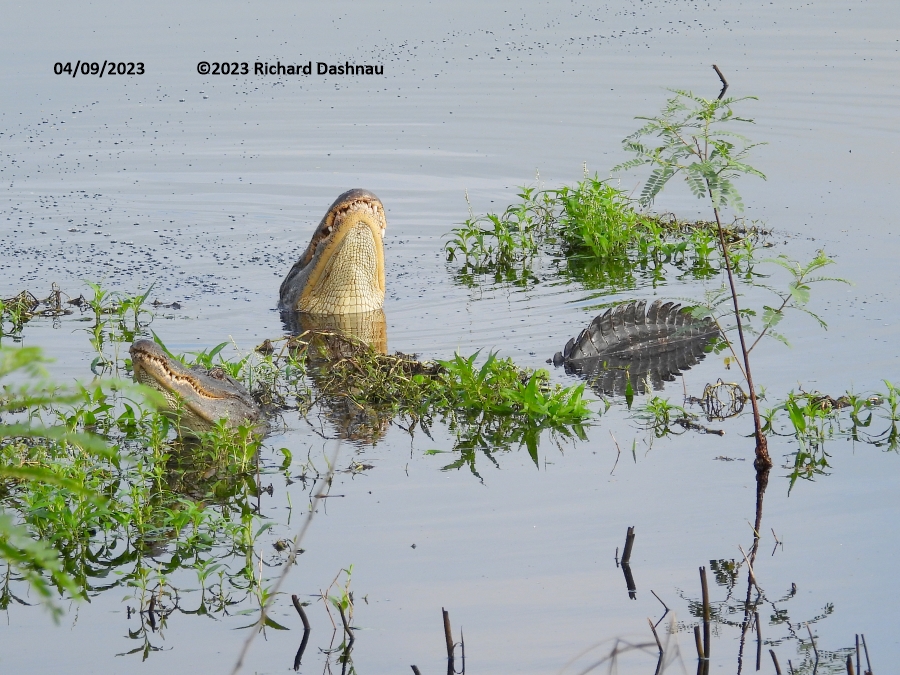
One
moved past him, and started bellowing. One female stayed near him while
the other moved closer to the bank and bellowed. The chorus went on for a
few minutes more, then
was over by 9am. What a wonderful way to spend 20 minutes! I've put
together a short video clip that shares some of the highlights, until the
breeze woke up, and blew on the
microphones. You can view the video
at this link. There are more examples of alligator
communication on my other web pages. Here is one of them.
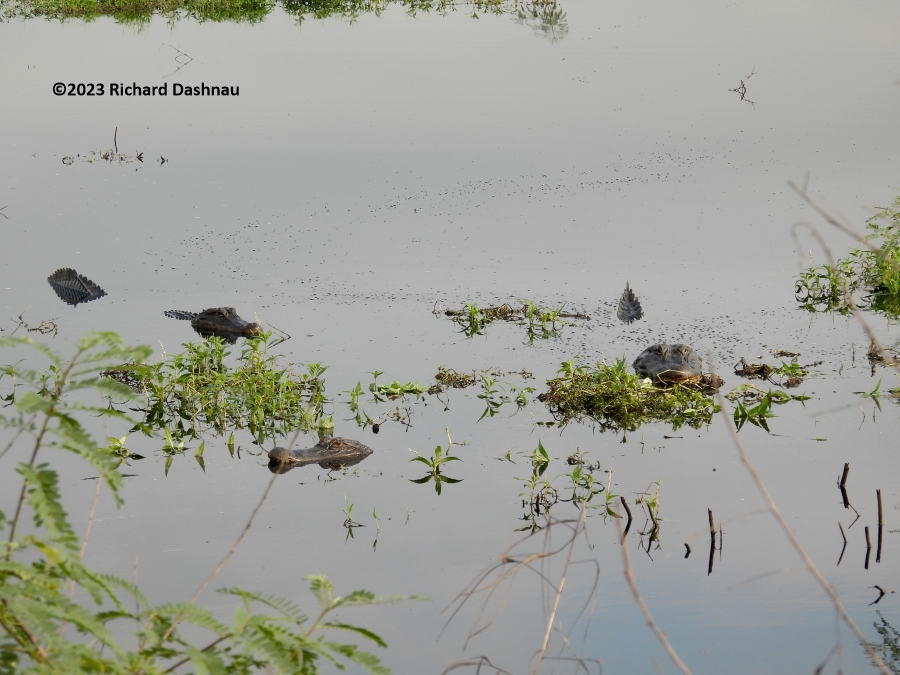
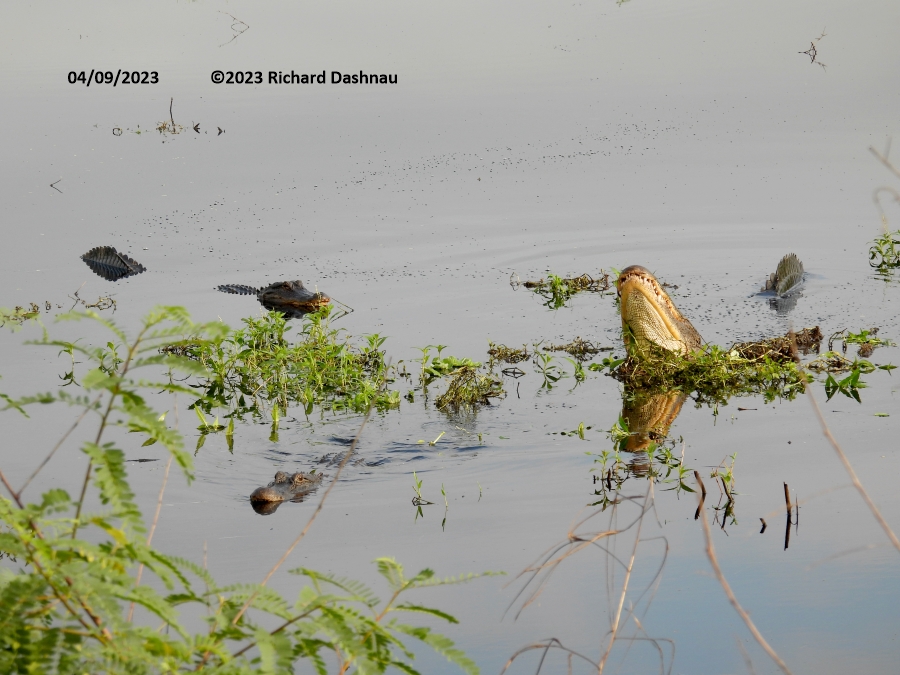
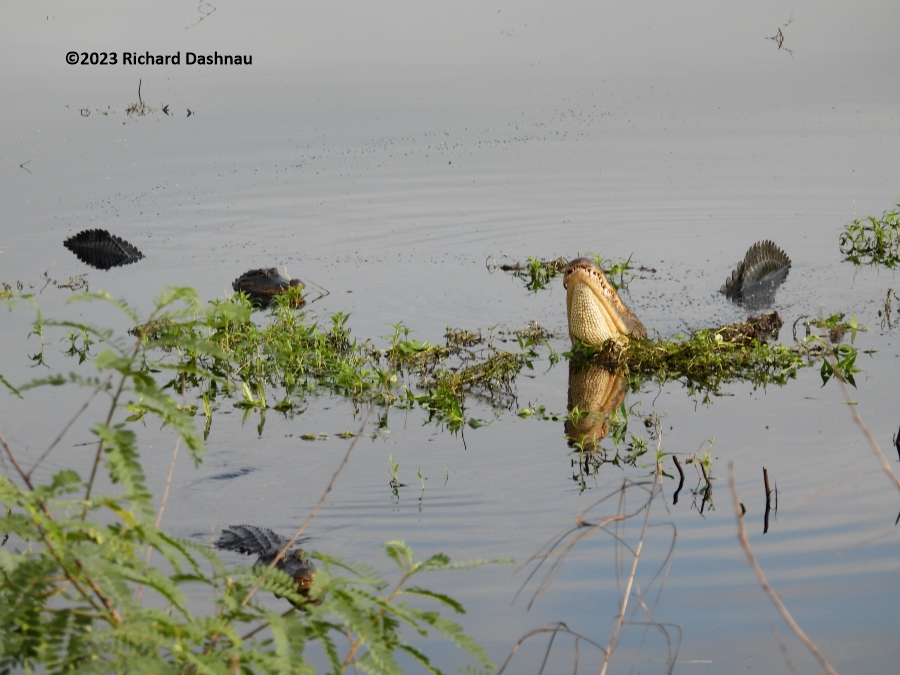
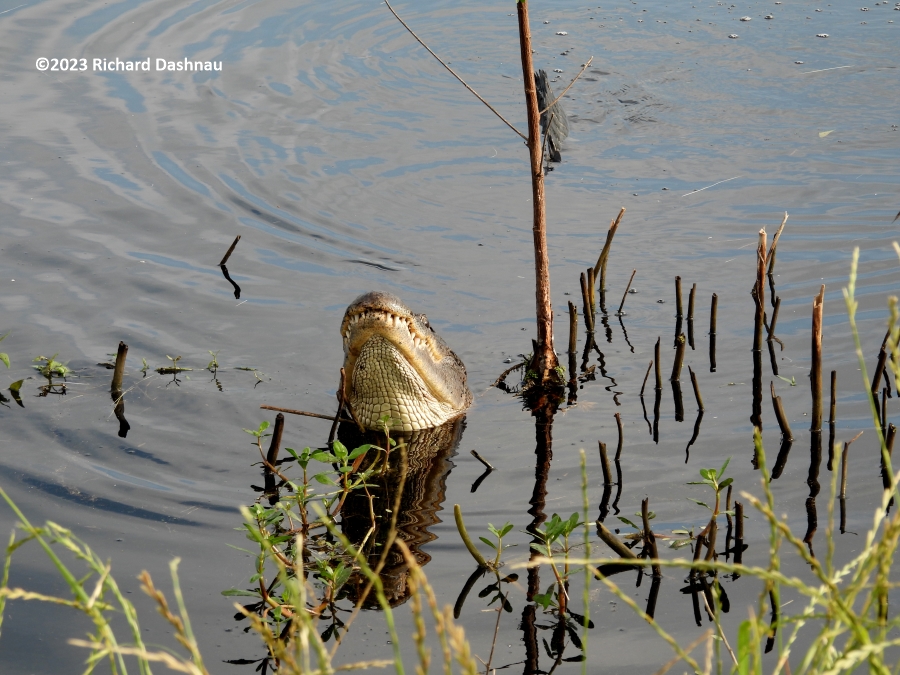
Another
alligator in Pilant Lake was swimming toward a spot the trail about 40
yards away. When I got there, I found the alligator with its nose
against the bank. This often means the
alligator is about to leave the water and cross the trail, so I moved back
a bit and waited. The alligator climbed up and waited in the grass.
I pointed it out to several park visitors, and
some of them waited with me to see if the gator would cross. It did,
at about 9:45am. At first glance, the images below may all
look the same, but they are each a detailed part of a
single alligator step.
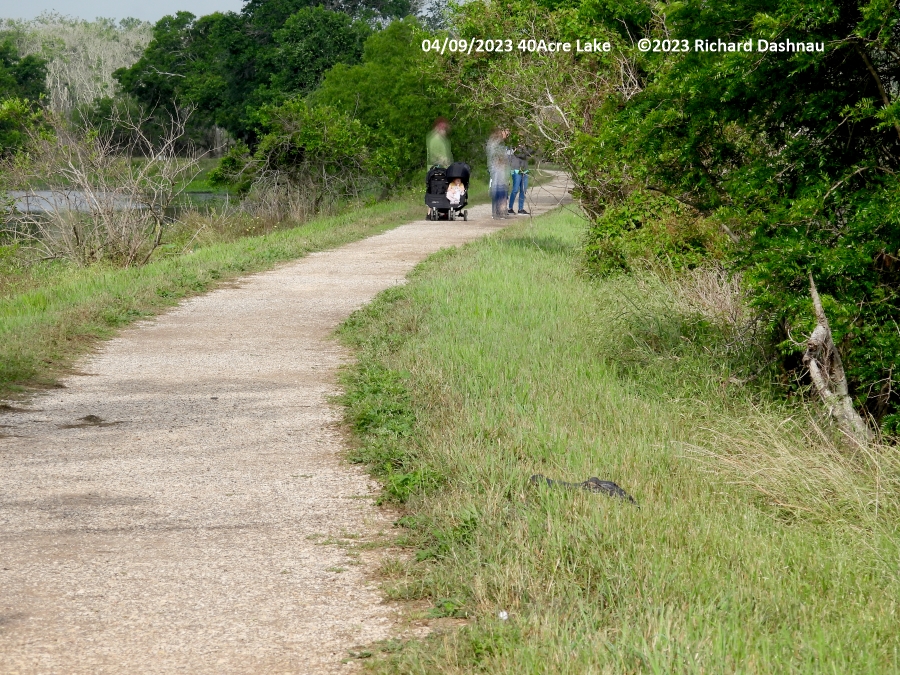
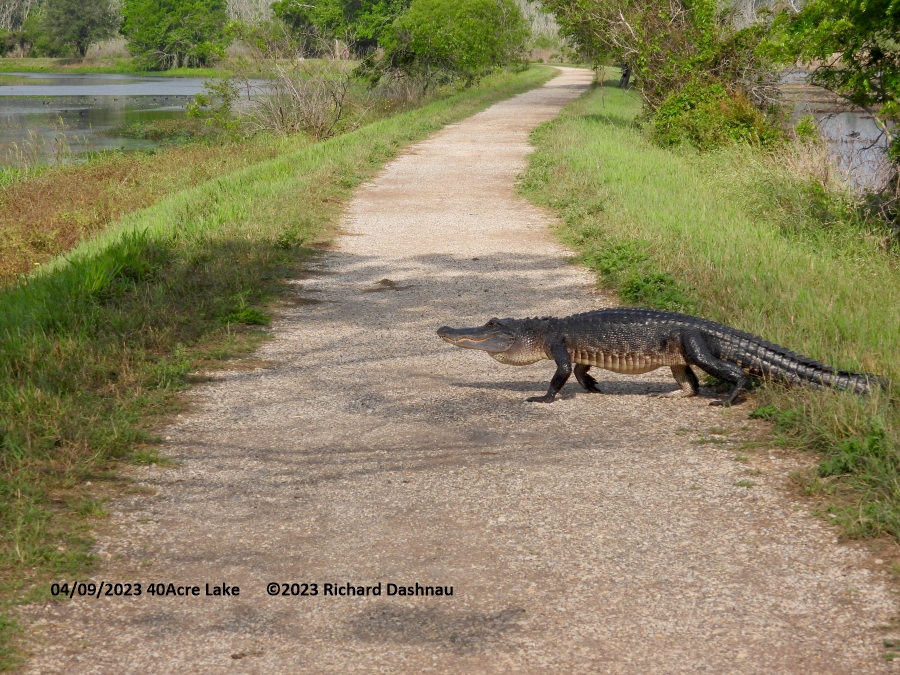
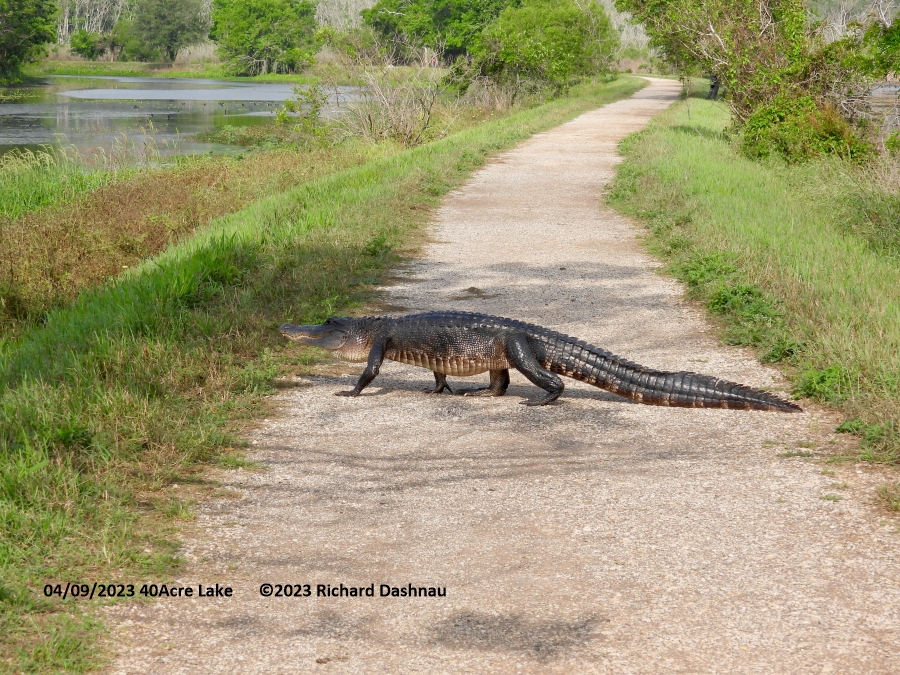
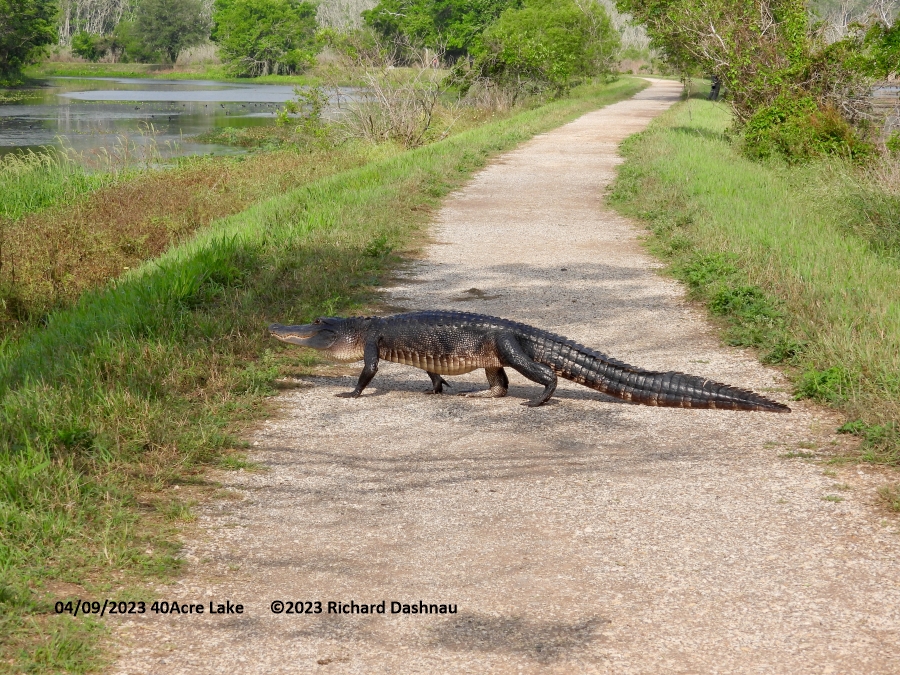
While
I'm on the trail, I usually carry a 6-foot staff with me. Among
other tasks, it's useful for demonstrating the width of the trail, and
with that, the length of an alligator crossing the
trail. Here, I show that the trail is about 2 feet wider than
my staff is long, or about 8 feet when placed near the alligator
crossing. The alligator was about 8 feet long. There are
many other examples of alligators moving over land on my other web pages.
Here
is one of them.
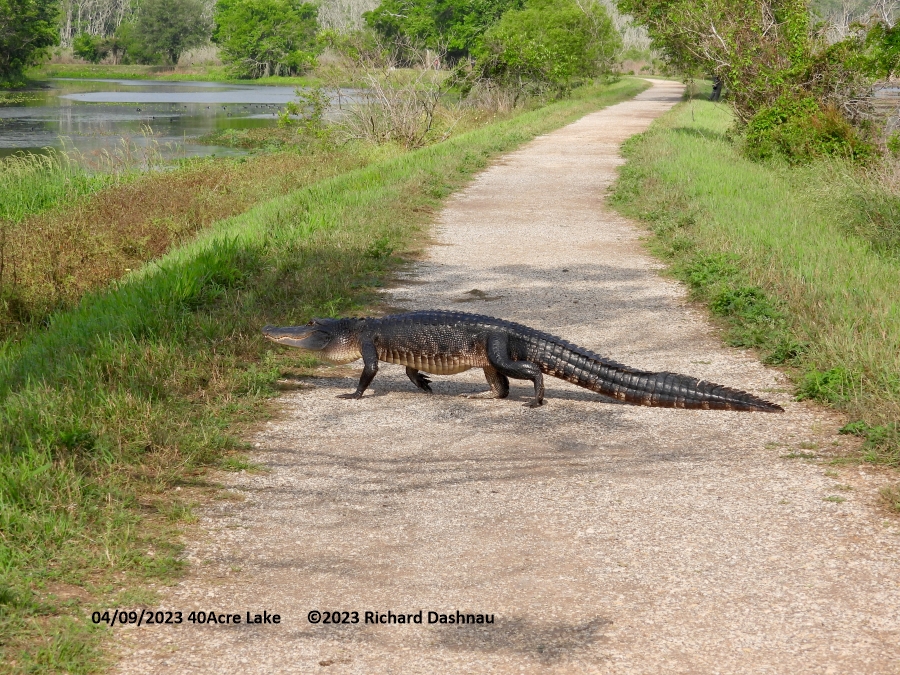
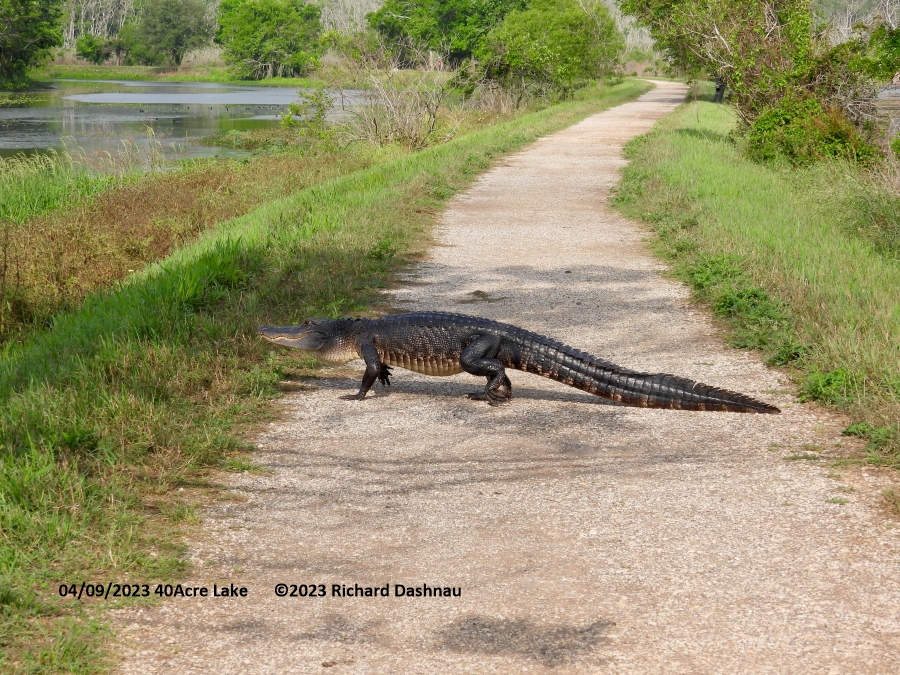
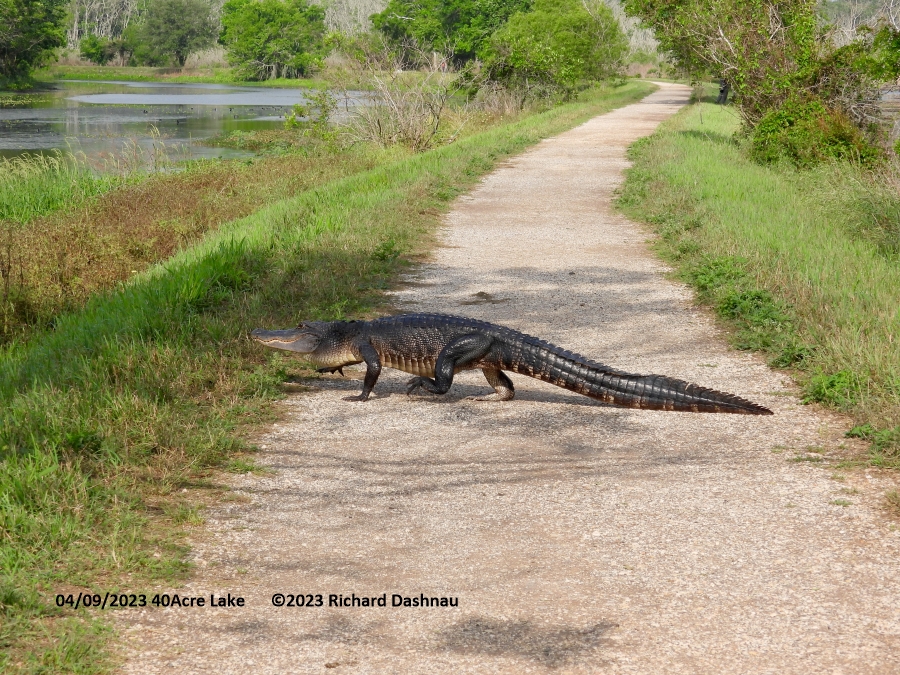
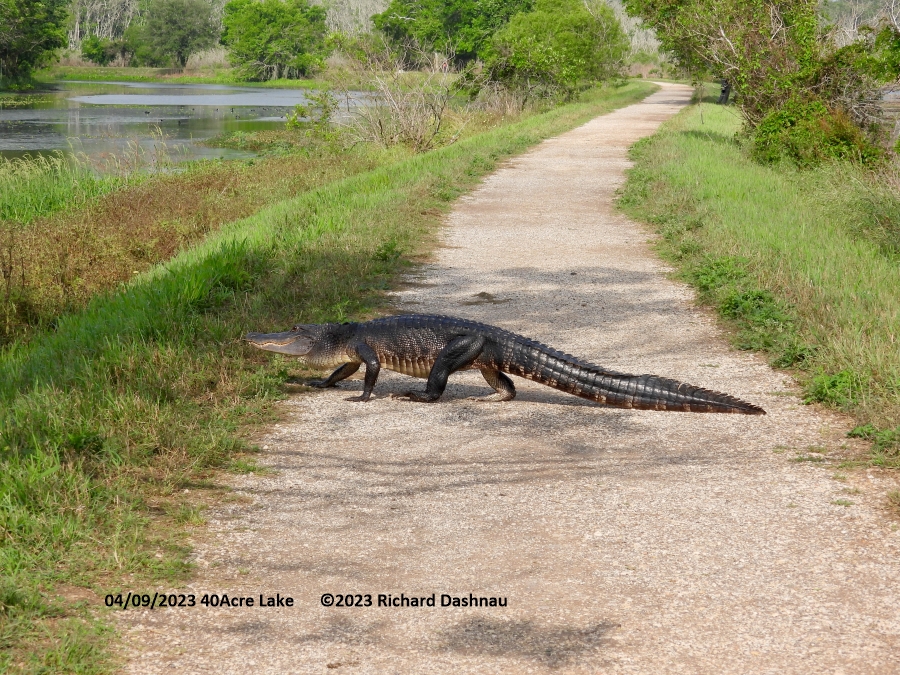
When
the alligator moved into 40 Acre Lake, it didn't bother to stand and
high-walk, it just slid across the mud. The images below show what a
fresh alligator slide mark
looks like-along with the gator that made it-and an older one to the left.
It's another example of animal traces, or ichnology - a recording of
animal behavior preserved in the
mud. To make a trace, there are three basic elements: 1)Substrate (the
mud); 2)Anatomy (the alligator's belly); 3)Behavior (sliding over
the mud).
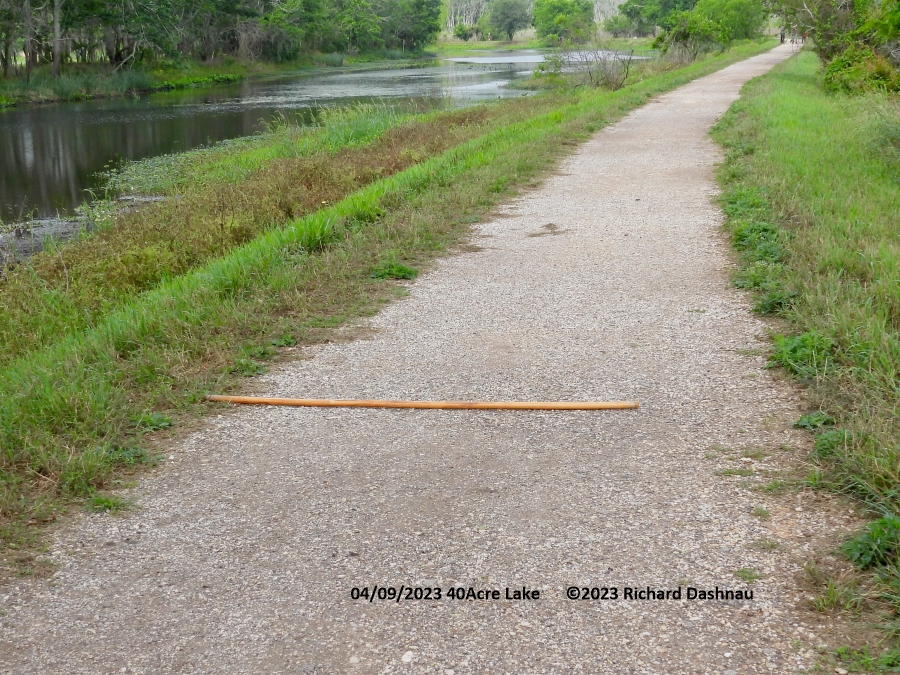
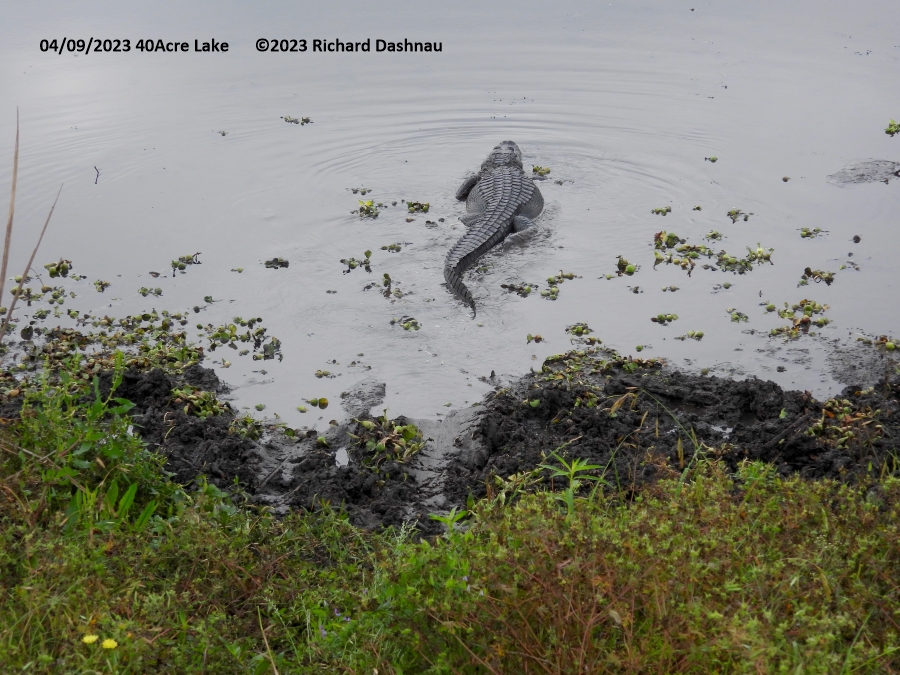
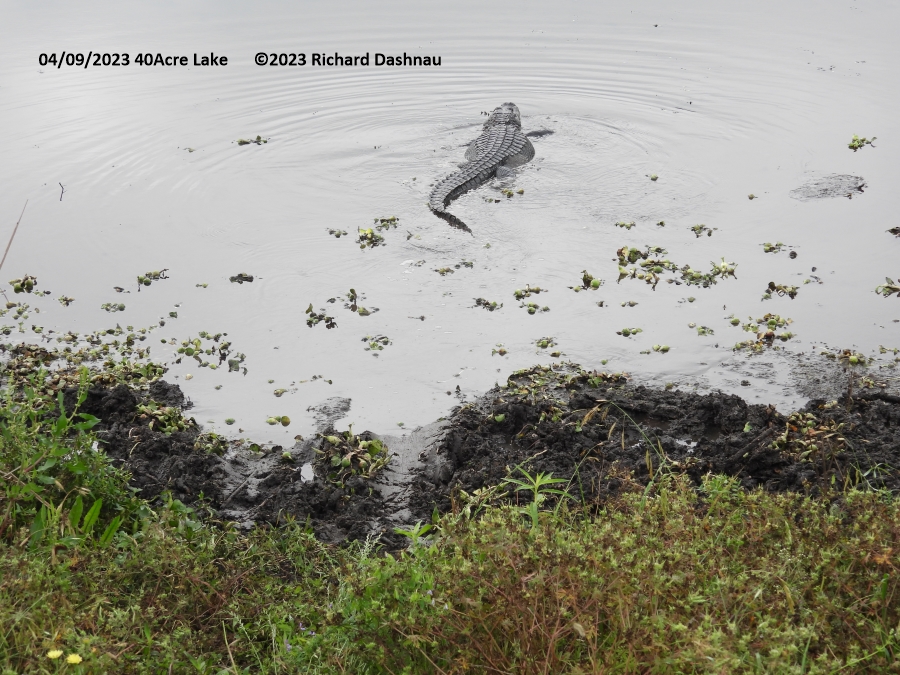
And,
this page shows alligators at the park,
on land, near various landmarks at the park.
Go back to my main alligator
page, Alligators
Go
back to my home page, Welcome to
rickubis.com
Go
back to the See
the World page.
























































































